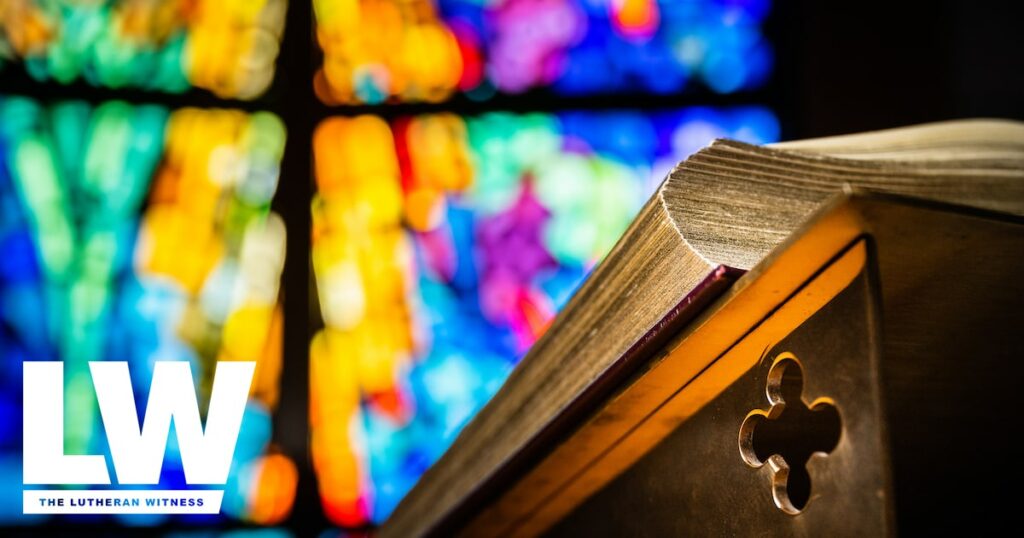Some of Luther’s most famous accolades for music came in a preface he wrote to musician Georg Rhau’s Delightful Symphonies (1538). “Next to the Word of God, music deserves the highest praise. . . . Whether you wish to comfort the sad, to terrify the happy, to encourage the despairing, to humble the proud, to calm the passionate, or to appease those full of hate. . . what more effective means than music could you find?” Those unaffected by the delights of music as a bearer of the Word of God “deserve to hear . . . the music of the pigs.”
Luther concludes his preface with a few sentences that could have been written yesterday: “Let this noble, wholesome, and cheerful creation of God be commended to you. By it you may escape shameful desires and bad company. At the same time you may by this creation accustom yourself to recognize and praise the Creator. Take special care to shun perverted minds who prostitute this lovely gift of nature and of art with their erotic rantings; and be quite assured that none but the devil goads them on to defy their very nature which would and should praise God its Maker with this gift, so that these [colorful word deleted] purloin the gift of God and use it to worship the foe of God, the enemy of nature and of this lovely art” (Luther’s Works, vol. 53, pp. 323–24).
The hymnals of Luther’s day contained orders and resources for services and prayers, along with hymns. In fact, it was the Lutheran Reformation, riding on the wave of Gutenberg’s press, that brought forth hymnals. And they’ve been a hit ever since. Some years ago, as the LCMS was working toward a new hymnal, the naysayers commented: “Well, you’re going to have a whole warehouse full of those things.” Even in this digital age, Lutheran Service Book (LSB) has far outperformed Lutheran Worship (1982), which peaked at only a 56 percent penetration among LCMS congregations. Today, LSB is used in nearly 90 percent of the Synod’s congregations. Its electronic version, Lutheran Service Builder, is used widely to assist congregations in printing bulletins. LSB is certainly one of the best-selling books in the history of Concordia Publishing House, with more than one million copies in print.
Luther applied his thoughts on Christian freedom to the matter of worship. Under the Gospel, “a Christian is a perfectly free lord of all, subject to none.” Under the law of love, “a Christian is a perfectly dutiful servant of all, subject to all” (Luther’s Works, vol. 31, p. 344). There is unbelievable freedom in worship (Gal. 5:1). Yet, as St. Paul teaches, we are to use our freedom in service to our neighbor, and we therefore accept limits to our freedom (Gal. 5:13). It would be irksome or even offensive for everyone to have completely different worship practices and forms every week, though it would not necessarily be sinful. Many would find it irksome and tiring to have no variety in the weekly service. The hymnal allows both stability and variety. To be sure, the freedom we have stretches beyond using the hymnal, so long as what is done in song and liturgy does not confound the Gospel and detract from Christ. We do say, however, that the order of the service should be followed. At the least, the parts of the service should be present.
Why? They hold up Christ and deliver the Gospel. We should not omit a clear confession of sins by the people and absolution by the pastor. We should not ditch the readings. We should and must preach textual sermons, with clear Law and Gospel applied directly to those present. The Lord’s Supper should follow confession and preaching as preparation. We should not be messing with the Lord’s Words of Institution. We are to be responsible in distributing the Sacrament to those who confess that the body and blood that are present and who are in confessional fellowship with us (see Explanation of the Small Catechism, especially Question 305). Exceptions are exceptions, not the rule.




I love worship and that includes the beautiful music. Worship offers freedom – freedom in Christ. We are no longer bound by sin but are free in Christ’s shedding of His blood and His resurrection. The old hymns and liturgy convey the unchanging gospel message. New music and hymns, if they are gospel centered, convey the same thing. Therefore, both styles are uplifting and life-changing. They draw the sinner closer to God and remind him of the power of the Gospel. They lead the worshipper to the throne of God which is where the worshipper finds forgiveness, peace, and mercy. What better place is there? There is no better place to be than in God’s holy presence. I love both traditional and contemporary worship. They both offer God’s precious, holy gifts. I love to adore and worship God for His mercy, forgiveness, holiness, and steadfast and never-ending love.
Worship is exciting. Tell me where there is a worship service and I’ll run to it!
David, there are some beautiful hymns in the LSB that are not ancient. Three examples: Thy Strong Word, The Lamb, What is this Bread. One of my favorite things to sing is in the Order of Prayer and Preaching. It is the Old Testament Canticle, absolutely beautiful!
Sadly, most “modern Christian” music does not reflect Lutheran doctrine. May I suggest you read the Fire and the Staff by Klemet Preus. It may help you with your struggle.
God’s blessings to you. I pray you find the peace you seek.
I would love to be Lutheran; I was baptized and confirmed as Lutheran (Missouri Synod), but I can’t stand sitting through a liturgical service that is antiquated. Can you say “snore.” Who says that old hymns are the only way to worship? Music is only a reflection of the times and culture we live in. I’m sure that early Christians might think that our hymns are scandalous (musically). I wish there was a Lutheran church close to me that would embrace modern worship but still be rooted in the teachings of Luther (sola scriptura, salvation by grace through faith, etc.). The fact is that young people leave traditional denominations like Lutheranism because of their rigidity and inability to modernize in practice (not in doctrine). It’s ridiculous. I aspired to be a Lutheran pastor, but would never venture to do so because of this issue; I didn’t want to be trapped in a prison of tradition in a church that would not embrace change (sorry, but this was my experience). It wasn’t a matter of unbelief. So I became a youth pastor in a Pentecostal denomination. This was a mistake, because I was not doctrinally aligned with the denomination. What would someone like me do considering the few options I have?
So, are you saying that Pastor Woolsey’s music is improper?
http://vimeo.com/47128920
If the link is a pastor, then, yes it is improper and unworthy of worship.
Well put. And the ‘very least’ you write of should be a benchmark for growth in liturgical wealth, not a tiresome uniformity.
The hymnal has 5 orders of service. In the course of a year, if all five aren’t used, there’s no good reason to ‘design ‘ a ‘liturgy ‘ outside of its pages.